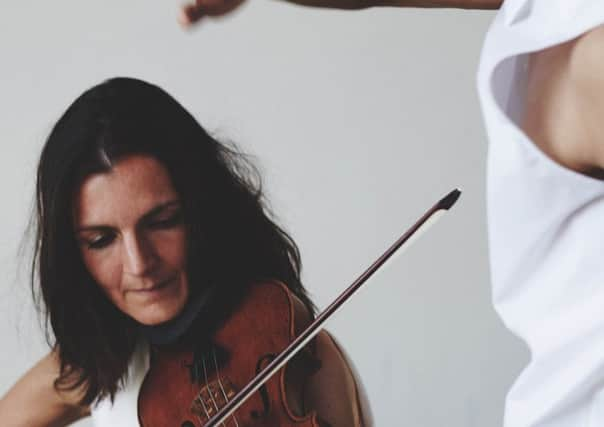The Scottish Ensembles’s adventurous new season


Is it enough, any more, to stick a group of talented string players on stage and get them to play a standard set of Bach, Mozart and Mendelssohn with a bit of modern thrown in for good measure?
Well, it’s a long time since the Scottish Ensemble could be categorised in such a routine way, and it’s certainly not the way it profiles itself nowadays. But if distinctiveness matters in justifying any such group’s existence, and keeping its players at the sharp edge of creativity, then the SE’s new 2015-16 season – announced this weekend – ticks a good many boxes.
Advertisement
Hide AdThere are two strands in particular that stand out as both exciting and original. The most significant is a focus on cross art form collaboration; the second is the further development of the SE’s residency programme, which takes them into communities as diverse as Dundee and Shetland, encompassing a mix of performance and creative learning activity.
“The first of these represents the biggest change in our programming,” says general manager Fraser Anderson. It follows on from last September’s 20th Century Perspectives in which the Ensemble collaborated with artist Toby Paterson in a programme presented in an abandoned part of the controversial modernist Anderston Centre building in Glasgow.
“The idea there was to showcase the 20th century music that our artistic director Jonathan Morton is so passionate about in the context of newly commissioned artwork and in a way that would really engage audiences,” Anderson explains. More importantly, it’s success was a sign to artistic director Morton that his players and audiences were open to further cross-media experimentation.
Paradoxically, next season’s cross-art spectacular takes age-old Bach as its starting point, though given a modern twist resulting from the Ensemble’s second collaboration with Swedish contemporary dance company Andersson Dance. The programme – to be premiered in Sweden in September before featuring in home season performances in November – centres on Bach’s epic and endlessly inventive Goldberg Variations, in a mixture of string arrangements by Dmitry Sitkovetsky.
The interesting bit is that the musicians will not – as is the SE’s trademark style – simply stand and deliver. They will move around as they play alongside five of the Swedish company’s dancers. It’s an approach, says Anderson, that challenges the static nature of the typical classical concert.
Why choose Bach? “We explored all the repertoire options, but felt that this music would really work well to choreography on stage,” he explains. And for those wondering how musicians will react to having to dance as they play, the project is already beginning to take shape.
Advertisement
Hide Ad“We had our first development session a week ago where the players met the choreographer and one of the dancers for the first time. There was a bit of nervousness to begin with, but by the end of the second day it was remarkable what they had achieved, creating their own solo movement to fit into the work. It’s wonderful to see this initial part of the creative process, where the musicians are placed right at the heart of things and respond really well.”
That may be the SE’s most extreme example of its stated aspiration “to take standard repertoire and do new things with it”. But it’s a thread that feeds through most of its new season.
Advertisement
Hide AdTake October’s opening programme, In Schubert’s Company, which aims to explore the deeper side of Schubert’s short life and circle of influence. It will feature the brilliant British-Ukrainian violist Maxim Rysanov in Schubert’s Arpeggione Sonata, a work originally written for bowed guitar, but heard here in a version by Dobrinka Tabakova for solo viola and string orchestra, as well as Mahler’s arrangement of the Death and the Maiden string quartet.
Other concerts in the season also hinge around notable soloists. In December’s Three Pärt’s Bach programme – which is way more Bach than Pärt – Matthew Truscott, leader of the Orchestra of the Age of Enlightenment, appears as guest director and violin soloist in two of Bach’s concertos. In May 2016, Nicola Benedetti returns to the Ensemble that helped establish her as a soloist, playing mainly Vivaldi.
More intriguing, though, is March’s South Atlantic Crossings, which not only juxtaposes the classical European genius of Mozart with the Latin-American sensuality of Piazolla, Golijov and Villa-Lobos, but does so with Venezuelan pianist Gabriel Montero centre stage.
Known for her idiosyncratic improvisations and exuberant persona, Montero will end her appearance by calling for audience ideas with which to improvise a spontaneous encore.
Other season offerings include music by Debussy and Ravel, Mozart and Brahms, and a pre-season bash at the Royal Conservatoire of Scotland, where the Ensemble teams up with RCS students in a performance of George Enescu’s Octet for Strings, arranged for full string orchestra.
The SE is appearing at Romania’s Enescu Festival in September, and later in Instanbul, but its Scotland-wide residences – over and above its regular concert fixtures in Glasgow, Edinburgh, Perth, Aberdeen and Inverness – will now be extended beyond the likes of Dundee and Shetland, to include Dumfries and Mull for the first time.
Advertisement
Hide Ad“These are very important to us,” says Anderson. “They enable us to embed creative learning and more informal participatory events into our central concert activity. Like our core concert programmes, they are just another way in which we can tell stories through the repertoire we play and the way we talk about it.”
• Full information on the Scottish Ensemble’s 2015-16 season is at www.scottishensemble.co.uk